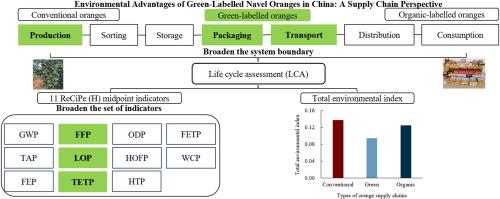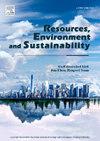Environmental advantages of green-labelled navel oranges in China: A supply chain perspective
IF 7.8
Q1 ENVIRONMENTAL SCIENCES
引用次数: 0
Abstract
Quantifying the environmental performance (EP) of citrus supply chains (SCs) via life cycle assessment is important for optimising fruit production for sufficient vitamin and micronutrient provision at lower environmental costs. As a part of national programme in China, green-labelled navel oranges use up to 50.0 % less chemical nitrogen fertilisers and become increasingly popular for their high quality. However, their EP remain unclear from the full SC perspective, and critical indicators, e.g. ecotoxicity and land occupation potential (LOP), have been mostly neglected in previous studies. Based on interviews with orange SC (OSC) stakeholders, this study analyses eleven ReCiPe2016 (H) midpoint indicators and normalises characterised results, followed by Monte Carlo simulation, to compare the EP of conventional, green-labelled, and organic-labelled OSCs from production to consumption. Green-labelled OSCs show lower impacts across most categories. Specifically, they reduce the LOP by 72.6 % compared with organic-labelled OSCs and decrease the ozone depletion potential by 65.5 % relative to conventional OSCs. Their total environmental index is 31.4 % and 24.5 % lower than conventional and organic-labelled OSCs, respectively. Packaging, transport, and production are significant contributing stages. Key contributing inputs include nitrogen fertiliser, corrugated boxes, long-distance transport, and land use. Beyond well-recognised fossil fuel potential, terrestrial ecotoxicity potential and LOP are newly identified critical indicators for OSC evaluation. Thus, green-labelled OSCs represent a more environment-friendly model for high-yield and high-quality fruit supply. This multi-stage and multi-indicator approach offers a transferable framework for comprehensive evaluation and optimisation of fruit SCs towards sustainable fruit provision and environment management.

绿色标签脐橙在中国的环境优势:供应链视角
通过生命周期评估量化柑橘供应链(SCs)的环境绩效(EP)对于优化水果生产,以更低的环境成本提供充足的维生素和微量营养素非常重要。作为中国国家计划的一部分,绿色脐橙使用的化学氮肥减少了50.0%,并因其高品质而越来越受欢迎。然而,从全生态系统的角度来看,它们的EP仍不清楚,而生态毒性和土地占用潜力(LOP)等关键指标在以往的研究中大多被忽视。基于对橙色SC (OSC)利益相关者的访谈,本研究分析了11个ReCiPe2016 (H)中点指标,并对特征结果进行了归一化,随后进行了蒙特卡罗模拟,以比较传统,绿色标签和有机标签的OSC从生产到消费的EP。绿色标签的osc在大多数类别中显示出较低的影响。具体而言,与有机标记的海洋有机化合物相比,它们的LOP降低了72.6%,与传统海洋有机化合物相比,臭氧消耗潜力降低了65.5%。它们的总环境指数分别比传统的和有机标签的OSCs低31.4%和24.5%。包装、运输和生产是重要的贡献阶段。关键的贡献投入包括氮肥、瓦楞纸箱、长途运输和土地利用。除了公认的化石燃料潜力之外,陆地生态毒性潜力和LOP是最近确定的盐含量评价的关键指标。因此,绿色标签osc代表了一种更环保的高产优质水果供应模式。这种多阶段、多指标的方法为水果SCs的综合评估和优化提供了一个可转移的框架,以实现可持续水果供应和环境管理。
本文章由计算机程序翻译,如有差异,请以英文原文为准。
求助全文
约1分钟内获得全文
求助全文
来源期刊

Resources Environment and Sustainability
Environmental Science-Environmental Science (miscellaneous)
CiteScore
15.10
自引率
0.00%
发文量
41
审稿时长
33 days
 求助内容:
求助内容: 应助结果提醒方式:
应助结果提醒方式:


